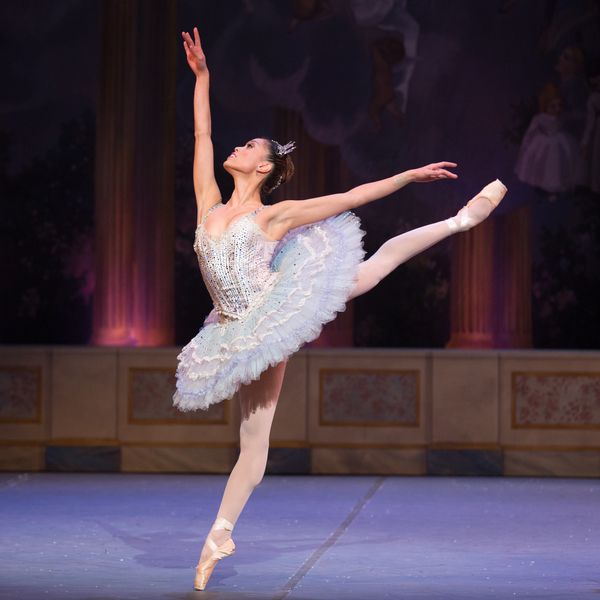What It's Really Like to Be a Principal Dancer in a Ballet Company
It was Valentine’s Day when then–16-year-old Lia Cirio auditioned for Boston Ballet—and was hired on the spot. Every year since, Cirio has celebrated February 14th as not only a day for teddy bears and chocolates, but also as the day she became a professional ballet dancer.
Now, Cirio is a principal at the company, and she knows firsthand that it takes more than a solid supply of pointe shoes (though she can go through 30 pairs in a week!) to survive the ballet world. From the glowing highlights to the frustrating letdowns, Cirio shares what it’s really like to be a principal dancer in a world-class ballet company.
Ups and Downs
Cirio’s rise in the company was steady: She achieved principal status within six years of joining Boston Ballet. But even a relatively smooth ride through the ranks can feel like a rollercoaster.
 John Lam and Cirio in George Balanchine’s “Stravinsky Violin Concerto” (photo by Igor Burlak Photography, courtesy Boston Ballet)
John Lam and Cirio in George Balanchine’s “Stravinsky Violin Concerto” (photo by Igor Burlak Photography, courtesy Boston Ballet)
Cirio recalls some of her proudest moments with Boston Ballet: dancing her first principal role, going onstage after learning a part in one day, and performing her first full-length ballet. “I feel most proud whenever I triumph over a particularly difficult part,” Cirio says. “I’m happiest when I’m getting the opportunity to grow and learn more about myself as an artist.”
Yet, despite her success, Cirio has always struggled with confidence, and that’s something she’s had to work on consistently. Competition is inherent to the ballet world, and the pressure can take its toll. “I’m not a competitive person,” Cirio explains. “At times, I found it debilitating to be competing day in and day out.”
During her second season as principal, Boston Ballet performed Cranko’s Romeo and Juliet, and to Cirio’s disappointment, she wasn’t cast as Juliet—one of her dream roles. “I was devastated, and my dancing suffered tremendously as a result,” she says. But she soon learned that the ability to handle rejection well is an essential skill—even at the top ranks of a company.
“Throughout my career, I’ve dealt with the fact that I won’t be cast in certain roles because of the way I look,” she says. “It could be that I have darker skin, or the fact that I have broad shoulders—I don’t fit the ‘perfect’ description of a ballerina.” She’s glad that times are changing for ballet dancers of all shapes and colors, however, and hopes to shed even more light on this issue. “Instead of becoming angry, which is how I would’ve reacted before, I’ve learned to use the energy to better my dancing,” she says.
A Day in the Life
There are two kinds of days for a principal dancer at Boston Ballet: rehearsal days and performance days.
On a typical rehearsal day, dancers have class from 9:45 a.m. to 11:45 a.m., followed by up to six hours of rehearsal depending on what’s being rehearsed. “If I have breaks in my day, I like to occupy that time with Pilates and cross-training on the elliptical or bike. I do not deal well with not being busy,” Cirio says. “The busier I am, the happier I am. So I welcome the six hours of rehearsal!”
Performance days start around noon, with no more than two or three hours of rehearsals before show time. Shows typically begin at 7:30 p.m., and each dancer prepares differently. “I like to arrive at the theater about two hours before curtain,” says Cirio. “I usually do my makeup and hair, and then I begin a warm-up. But that all depends on what I’m dancing and where I am in the line-up of the show.”
Cirio notes that Boston Ballet’s repertoire is what has kept her there for nearly 15 years. From classical to neoclassical to contemporary, the dancers are exposed to many different styles. Plus, Cirio grew up with many of the dancers at Boston Ballet. “We’ve seen each other through the highs and lows of this career, and although we’re sometimes dysfunctional, hey, we’re family!” she says, laughing.
 Cirio in the studio with friend and fellow Boston Ballet principal Kathleen Breen Combes (via @msliac on Instagram)
Cirio in the studio with friend and fellow Boston Ballet principal Kathleen Breen Combes (via @msliac on Instagram)
Beyond Ballet
After her first year as a soloist, Cirio decided she needed some time away from ballet. “I was questioning whether or not I wanted to stay in the profession,” she says. She joined Trey McIntyre Project for its inaugural season, which gave her a great deal of perspective. Ultimately, Cirio realized she missed ballet. She returned to Boston, danced more than ever, was given challenging roles, and by the end of the season—yep, you guessed it—was promoted to principal.
These days, Cirio makes a conscious effort to maintain a good balance between ballet and, well, everything else. “It’s important to have a life outside the ballet—to have hobbies, and things to take your mind off the daily grind,” she says. “Friends and family give perspective and an outside life helps dancers become even better onstage.”
As for future plans, Cirio is currently taking courses in organizational communication and management to learn more about the social media aspect of ballet companies. “I’ve gotten some experience in that area thanks to Cirio Collective, a pickup company I run with my brother, Jeffrey Cirio,” she says. (Jeffrey is a principal with American Ballet Theatre in NYC.) “I’d love to see the Collective continue to grow.”




